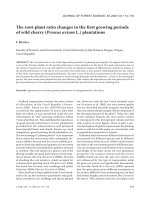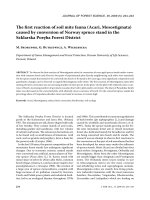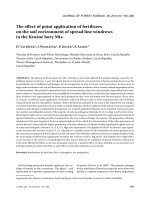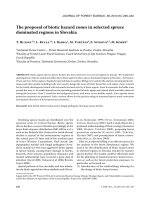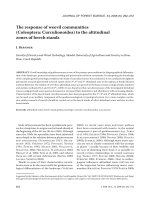Báo cáo lâm nghiệp: "The effect of nitrogen content on the of Scots pine needles and shoots photosynthesis" doc
Bạn đang xem bản rút gọn của tài liệu. Xem và tải ngay bản đầy đủ của tài liệu tại đây (151.4 KB, 3 trang )
The
effect
of
nitrogen
content
on
the
photosynthesis
of
Scots
pine
needles
and
shoots
H.
Smolander
1
P.
Oker-Blom
2
The
Finnish
Forest
Research
Institute,
Suonenjoki
Research
Station,
SF-77600
Suonenjoki,
and
2
University
of
Helsinki,
Department
of
Silviculture,
Unioninkatu
40
B,
SF-00170
Helsinki,
Finland
Introduction
A
close
dependency
between
photosyn-
thetic
capacity
and
nitrogen
content
of
leaves
has
been
shown
(e.g.,
DeJong,
1982).
For
coniferous
trees,
however,
a
large
variation
in
the
relationship
has
been
found.
It
has
been
proposed
that
the
rea-
son
for
this
could
be
that
the
nitrogen
content,
by
affecting
needle
growth,
changes
the
pattern
of
mutual
shading
within
a
shoot,
which
is
the
basic
element
used
in
studying
photosynthesis
of
conif-
erous
trees
(Linder
and
Rook,
1984).
The
aim
of
this
study
was
to
analyze
separate-
ly
the
effect
of
nitrogen
content
on
the
photosynthetic capacity
of
individual
needles
and
on
within-shoot
shading.
Needle
photosynthesis
was
approximated
by
measuring
the
photosynthesis
of
’thinned’
shoots
in
a
diffuse
radiation
field.
Within-shoot
shading
was
quantified
in
terms
of
the
mean
silhouette
area
to
total
needle
area
ratio
of
a
shoot,
which
deter-
mines
the
relative
interception
rate
per
unit
of
needle
area
on
the
shoot
(Oker-
Blom
and
Smolander,
1988).
Materials
and
Methods
One
yr
old
experimental
shoots
were
collected
from
5
young
Scots
pine
(Pinus
sylvestris
L.)
stands
in
Suonenjoki
(62°39’
N,
27°05’
E)
be-
tween
5
and
30
June
1988.
The
sites
of
the
stands
varied
from
poor
sandy
soil
with
Callu-
na
vulgaris
vegetation
to
a
fertile
site
with
grass-herb
vegetation.
A
randomly
selected
shoot
from
the
uppermost
whorl
of
each
tree
was
used
in
measurements
of
photosynthesis.
Morphological
characteristics
and
silhouette
to
total
needle
area
ratios
were
measured
for
a
shoot
from
the
uppermost
whorl
and
for
1 st
order
and
2nd
order
shoots
just
below.
The
photosynthetic
capacity
of
10
shoots
(2
trees/stand)
and
silhouette
to
total
needle
area
ratio
of
93
shoots
(3
trees/stand)
were
mea-
sured.
The
photosynthesis
of
excised
shoots
was
measured
in
a
diffuse
radiation
field
using
an
open
flow
IRGA-system.
In
order
to
eliminate
the
effect
of
within-shoot
shading,
about
two-
thirds
of
the
needles
on
a
shoot
were
removed
the
night
before
the
day
of
measurement.
The
air
temperature
was
20°C,
external
C0
2
concentration
was
340
ppm
and
vapor
pressure
deficit
5-10
mbar
in
the
chamber.
The
horizon-
tal
photon
irradiance
(measured
by
LI-190SR)
was
increased
in
an
integrating
sphere
from
0
to
1 000,
UMOI
-M-2-S-1
in
7
or
8
steps
and
a
stea-
dy
state
photosynthetic
rate
was
obtained
at
each
irradiance
level.
A
non-rectangular
hyper-
bola
was
fitted
to
the
measured
photosynthetic
rates
using
the
method
of
least
squares
and
the
value
at
2000
pmol
’
m-
2’
s-
1
was
used
as
an
estimate
of
the
photosynthetic
capacity.
The
silhouette
area
of
each
shoot
was
mea-
sured
photographically
at
6
different
inclinations
of
the
shoot
axis
to
the
plane
of
projection.
The
effect
of
asymmetry
of
the
shoot
was
eliminated
by
rotating
the
shoot
4
times
in
increments
of
60°
for
each
inclination
angle.
The
mean
sil-
houette
area
with
respect
to
a
spherical
shoot
orientation
was
calculated
as
a
weighted
aver-
age
of
the
24
silhouette
areas
measured.
The
mean
silhouette
to
total
needle
area
ratio
(STAR)
was
then
obtained
by
dividing
mean
sil-
houette
area
by
the
total
needle
area
of
a
shoot,
which
was
approximated
as
x
times
the
project-
ed
needle
area
(measured
by
a
LiCOR
leaf
area
meter)
Oker-Blom
and
Smolander,
1988).
Finally,
needles
were
dried
for
48
h
at
80°C
and
their
nitrogen
content
determined
by
the
Central
Laboratory
of
the
Finnish
Forest
Research
Institute
using
a
LECO
CHN-600
analyzer.
Results
and
Discussion
Despite
the
large
variation
in
site
fertility,
the
range
of
nitrogen
concentration
varied
only
from
0.49
to
1.5%
of
dry
weight
of
needles.
The
low
values
of
nitrogen
content
are
due
to
the
fact
that
measure-
ments
were
made
during
the
growing
phase
of
new
shoots.
The
photosynthetic
radiation
responses
of
the
shoots
measured
in
a
diffuse
radia-
tion
field
were
similar
to
those
measured
for
single
leaves
(Fig.
1
The
nitrogen
content
had
;a
clear
effect
on
the
photo-
synthetic
capacity
of
needles
(Fig.
2).
However,
because
of
the
narrow
range
of
nitrogen
content,
the
regression
was
not
as
close
as
is
generally
obtained
for
broadleaved
trees.
In
this
material,
the
nitrogen
conl:ent
explained
62%
of
the
variation
in
photosynthetic
capacity,
whe-
reas
coefficients
of
determination
>90%
are
typical
for
broadleaved
trees.
The
STAR-values
of
shoot
were
posi-
tively
correlated
to
nitrogen
contents
(Fig.
3),
contrary
to
what
we
had
expected.
Apparently,
some
changes
in
shoot
struc-
ture
eliminated
the
expected
increase
in
mutual
shading
caused
by
enhanced
needle
growth.
The
STAR-value
of
a
shoot
is
most
sensitive
to
the
needle
density
on
the
shoot
axis
and
the
angle
between
needle
and
shoot
axis,
while
needle
length,
for
example,
has
a
much
smaller
effect.
In
our
material,
the
needle
density
decreased
with
increasing
nitrogen
con-
tent
(Fig.
4)
and
the
needle
angle
increa-
sed
with
increasing
nitrogen
content
(Fig.
5).
In
conclusion,
nitrogen
content
can
increase
shoot
photosynthesis
in
2
ways:
by
increasing
photosynthetic
capacity
of
needles
and
by
increasing
light
intercep-
tion
efficiency
per
unit
area
of
needle
sur-
face
on
the
shoot.
References
DeJong
T.M.
(1982)
Leaf
nitrogen
content
and
C0
2
assimilation
capacity
in
peach.
J.
Am.
Hortic.
Sci.
107, 955-959
Linder
S.
&
Rook
D.A.
(1984)
Effects
of
mineral
nutrition
on
carbon
dioxide
exchange
and
parti-
tioning
of
carbon
in
trees.
In:
Nutrition
of
Plan-
tation
Forests.
(Bowen
G.D.
&
Nambiar
E.K.S.,
eds.),
Academic
Press,
London,
pp.
211-236
Oker-Blom
P.
&
Smolander
H.
(1988)
The
ratio
of
shoot
silhouette
area
to
total
needle
area
in
Scots
pine.
For.
Sci.
34,
894-906




